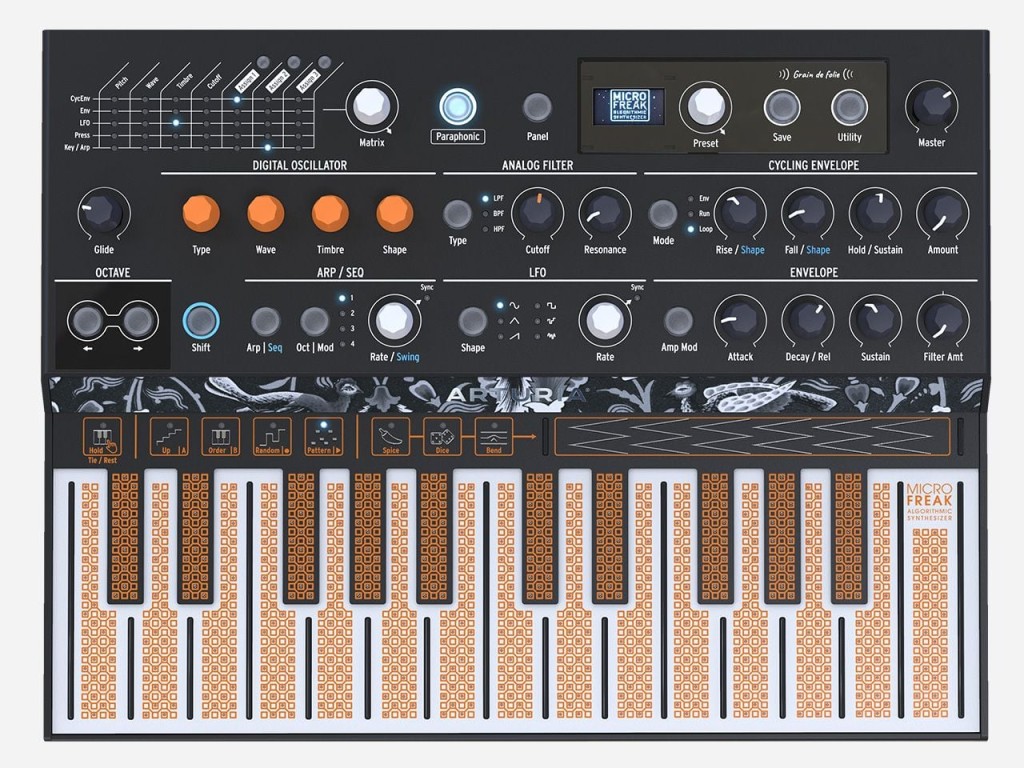The MicroFreak already offered a ton of sonic madness in a small package – like a little oscillation playground. The v4 firmware that just dropped is essential, both in kinky new features and some overdue smoothed-out kinks.
Wavetables are everywhere. The MicroFreak was a uniquely rich home to oscillator experimentation, though, even just with its stock wavetables. (This included some of the features of the Mutable Instruments oscillators and their wavetables, with a number of new twists, oscillator types, and wavetables – though it also made a great gateway drug to the Mutable line and various open-source recreations.)
Now you can load your own wavetables for even more possibilities – and there’s an expanded user wavetable oscillator (both with new dedicated waveform content and the ability to drag in your own sounds).
I spent a lot of time messing with the MicroFreak this fall, and I’m finishing up a guide. The short version is, this is a wonderfully strange little beastie. The deep modulation takes a little adaptation – the cost of that ultra-compact form factor is, you do have to do some finger gymnastics managing parameters and the push-button matrix. But if you’re willing to practice with that (and probably save some presets), it’s something special. It feels like a tiny modular rig with a keyboard – but at the price of about one half a comparable module. It’s like a little bottle of tabasco – though as such, maybe you want it alongside something else. Paired with effects, or as an extra voice with another synth, I found it delightful.
This v4 update is really worth some serious attention. It’s not just that they dropped in user wavetables; they also made it accessible.

WaveUser Oscillator
Midi Control Center, the companion desktop app, is now your home for managing the feature. Grab some WAV or AIFF – your own wavetable or one of the many you can find online – and just drag and drop them onto the software to load them.
There are 16 Arturia-provided wavetables, too, so you can start to work with this oscillator even before you open up the software and add your own wavetables. (You can also drag and drop wavetables from the other wavetable oscillator, in case you want to use one of the other factory options with the bit depth option mentioned below instead of chorus.)
This thing is even cooler than it appears at first glance – there’s a lot of smart DSP work done here in the editor.

First, Arturia put a lot of thought into the software. It allows you to import wavetables at 32 cycles x 2048 samples each – the same as on Arturia’s Pigments. It then converts them in Midi Control Center so that you get 256 samples per cycle.
There are also some details to how Midi Control Center handles cycles. If you have a short audio file with less than 8 cycles, the MicroFreak will spread them across the slots. If you have more than 8 cycles, it will do some crossfading so you get a continuous waveform.
The upshot of this is you can drag-and-drop wavetables you use with Pigments or files you’d find online (labeled for Ableton Wavetable or Serum, for instance). You can also just drop short AIFF or WAV files you find and see what happens.
You even get little onscreen animations for added feedback, both to see what’s up with your imported files and to navigate the default banks.
There’s also, as with the previous Wavetable oscillator, the possibility of wavesequencing – routing modulation to Wave and then shifting through different waveforms for even more variety.
Also important to know – Shape on this oscillator controls bit depth, continuously modulating through bits for some crunchy lo-fi effects. (The original wavetable oscillator is set to Chorus.)
Other improvements
Believe it or not, nice as that is, I’m more excited by some fit-and-finish improvements.
Chord and Unison playback in Sequencer. You can now use the sequencer both in Chord and Unison modes. This is a big deal, especially as a lot of the joy of the MicroBrute is adding some clever sequencing and modulation and getting some weird and wild pattern going.
Accelerated encoders. From the Utility menu, you can now modify the speed of an encoder for an Oscillator. If you had seen me play this keyboard live, you’d know why – as you watched me furiously trying to turn an encoder to dial through a parameter. This one change alone has me more likely to play the MicroFreak.
No more clicks. It seems in addition to doing the work on the user wavetables, Arturia did some DSP cleanup on that wavetable engine. Most noticeably, they got rid of some clicks you’d sometimes hear when modulating the position on the WaveTable oscillator. (I just drenched mine in reverb, but this is a welcome change.)
They also fixed a bug with parameter display where the screen would sometimes blink to a parameter when you didn’t expect. (I think this was just some oversensitive touch tuning, but whatever it was, it’s listed as fixed in the changelog and I do notice it’s gone.)
Also:
- Reworked “Wavetable” Ocscillator’s audio engine
- Octave Led Blinking can now be disabled from Utility menu
- Removed “User Preset Erase” feature
It’s just a terrific value, wonderfully portable, and now really feels a lot more finished and usable and hackable.
https://www.arturia.com/products/hardware-synths/microfreak/overview